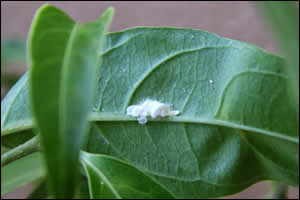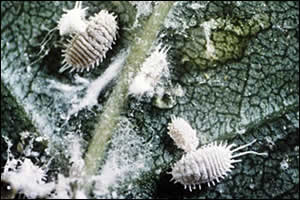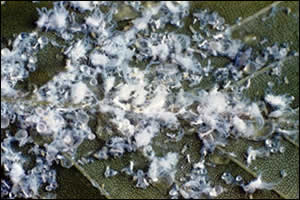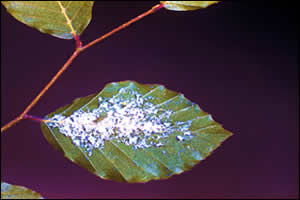MEALY BUGS, SCALE INSECTS OR WOOLLY APHIDS
All are virtually the same or very similar and cover 25 different species. They generally remain static on plants and feed by sucking sap from the leaves and stems of their host plants. All species have a shell-like waxy covering over their bodies when mature. The females’ eggs are often laid under the protection of this shell but with the cushion scales (e.g. Pulvinaria species) the eggs are deposited outside the scale under a mass of white waxy fibres. Young nymphs, known as crawlers, hatch some weeks later and disperse over the plant, settling to feed on sap thereby weakening the tree.
Most of these aphids are species specific and live on only that particular species of plant but they should all be treated in the same way and affected leaves burned and disposed of; they may not kill but they make a serious mess of the trees they attack. They only produce one generation a year except in heated greenhouses where they will continue reproducing throughout the year.






Scale insects; adult females look like hard or soft bumps on stems, leaves, or fruit; males are minute flying insects and larvae are tiny, soft, crawling insects with threadlike mouthparts. They can be found on many fruits, indoor plants, ornamental shrubs, and trees throughout North America. All stages suck plant sap, therefore weakening plants. Plants become yellow, drop leaves, and may die. Honeydew is also excreted onto foliage.
TREATMENT
The newly hatched scale nymphs are at their most vulnerable early to mid-summer and it is then that you should spray with a systemic insecticide and later with Malathion. Adult scales are impenetrable and must be removed individually by hand. Scrub scales gently from twigs with soft brush and soapy water, and rinse well.
Mealybugs are common insects that tend to live together in clusters in inaccessible parts of plants, such as leaf axils, leaf sheaths, between twining stems and under loose bark. There are also mealybug species found on plant roots. Mealybugs suck sap from plants and then excrete the excess sugars as a substance called honeydew. This lands on the leaves and stems where it is often colonised by sooty moulds, giving the surfaces a blackened appearance.
You may see the following symptoms:
- Mealybug is usually first noticed as a fluffy white wax produced in the leaf axils or other sheltered places on the plant. The insects or their orange-pink eggs can be found underneath this substance
- Large numbers of mealybugs may result in an accumulation of honeydew. This makes plants sticky and encourages the growth of sooty moulds, giving leaf and stem surfaces a blackened appearance
- Severe infestations will reduce plant vigour and stunt growth. Heavy infestations may cause premature leaf fall. Root mealybugs (Rhizoecus species) are also covered in a white waxy substance and found on plant roots. The golden root mealybug is yellow in colour.
CONTROL
- Female mealybugs do not fly nor crawl far, so infestations are usually brought in on an infested plant. Inspect new plants carefully before putting them in a greenhouse or conservatory and where possible keep them in quarantine (isolated from other plants) for at least a month before adding new acquisitions to an existing collection.
- Dead leaves and prunings should be removed from the greenhouse as these may have mealybugs or eggs on them.
- It can be simpler to dispose of heavily infested plants rather than try to eliminate mealybugs.
- Organic sprays, such as natural pyrethrum (e.g. Bug Clear Gun can afford some control. These pesticides have a very short persistence and so may require re-application to keep mealybugs in check. More persistent insecticides include e.g. Westland Resolva Pest Killer